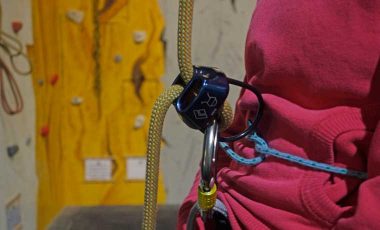The belay device; an essential item for sport climbing, trad climbing, alpine climbing and mountaineering. In this article you’ll find a no-nonsense summary of the different types of belay device out there. You’ll find out exactly what belay devices are, including a quick overview of each type of belay device by category. Then embark on a short summary of how they work, where they work best, and then finish off with a few recommendations for would-be buyers.
- What is a belay device?
- A short history of belay devices
- Belay device types
- Tubular belay device
- Assisted braking belay device (passive)
- Assisted braking belay device (active)
- Figure 8 belay device
What is a belay device?
In short, the term “belay device” refers to any instrument that can be used to secure a partner while they climb or yourself while you descend from a fixed anchor. They do so either by means of friction placed on the climbing rope as it passes through the device with the assistance of the belayer or, in the case of active assisted-braking devices, by using a mechanized lock that cinches down when weight or sudden force is applied to the rope.
A short history of belay devices
Since climbing’s early days as an outdoor sporting pursuit, the means used to ensure the climber’s well-being when taking a flier or abseiling have evolved somewhat dramatically.
While the sport was in its infancy, the belay device took the form of one’s own body, with the rope being wrapped around the rib cage or shoulders to provide the necessary friction when braking. As you’d imagine, the potential for serious rope burn, “big-whippers” and soiled underpants was high!
The subsequent introduction of some solid ironmongery went some way towards improving matters. Then, in 1970, the worlds of climbers everywhere were rocked (and their life expectancies dramatically increased) with the invention of the Sticht plate — a small, coin-like device with two slots for geometric braking. This device not only spared climbers from the ravages of rope-burn and rocky landings, but also provided the immediate precursor to the vast majority of belay devices we know today.
Fast forward a few years — to 1991, to be exact — and another seismological shift in climbing apparatus took place with the introduction of the Grigri, an assisted-braking device that revolutionized the way we look landward when suspended some ways above it on a narrow strand of nylon.
Belay device types
Disclaimer: We use affiliate links and may receive a small commission on purchases.
| Product | Type | Best for | Cost | |
|---|---|---|---|---|
| Black Diamond ATC-Guide Belay Device | Tubular | All types of climbing | $$ | |
| Petzl Reverso 4 Belay Device | Tubular | All types of climbing | $$ | |
| Mammut Smart 2.0 Belay Device | Assisted braking (passive) | All types of climbing | $$ | |
| Elderid Mega Jul | Assisted braking (passive) | All types of climbing | $$ | |
| Petzl Grigri 2 Belay Device | Assisted braking (active) | Crag and sport climbing | $$$$ | |
| Camp USA Matik Belay Device | Assisted braking (active) | Crag and sport climbing | $$$$$ | |
| Black Diamond Super 8 Belay Device | Figure 8 | Multi-pitch trad routes and alpine climbing | $ |
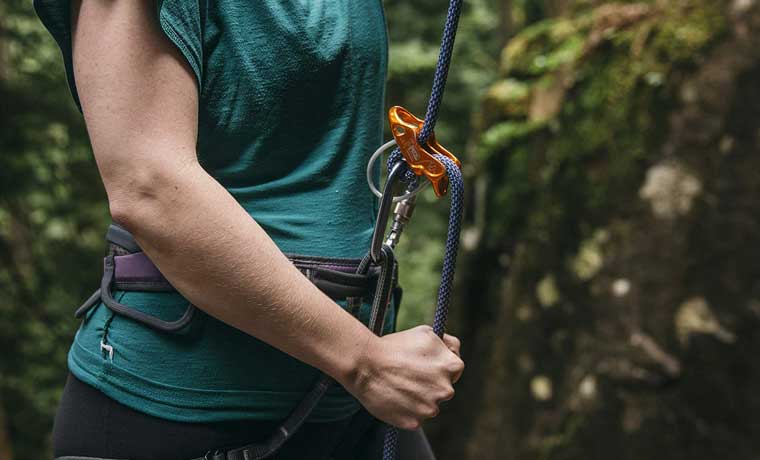
Tubular belay device
Prior to the invention of the assisted-braking belay device, the tubular belay device reigned supreme. Even today, when devices such as the Petzl GriGri are all but ubiquitous, the easy-to-use, fuss-free simplicity and versatility of “tubers” means they’re still a firm favorite with crag climbers, trad climbers, and mountaineers everywhere.
Main benefits of tubular belay devices:
- Easy to use
- Cheap
- Lightweight
- Direct belaying from anchor point on multi-pitch routes
How it works
A bight in the rope(s) is fed through the opening in the device and a karabiner clipped through both the bight and the wire attachment loop
When climbing, rope is fed out to the climber with one hand and the other hand holds the rope below the device in the braking position, ready to seize the rope should the climber take a tumble.
What scenarios it’s best suited to
- Any and all (though not as effective or practical when the lead climber is a lot heavier than the belayer or is resting/”hanging” a lot on a difficult route)
- Climbing with twin ropes/half ropes
- Belaying two seconding climbers directly from an anchor point
What sort of climbing is it best suited to
- Mountaineering
- Multi-pitch climbing
- Trad climbing
- Crag climbing
Tubular belay device options
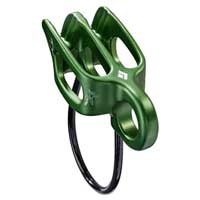
Black Diamond ATC-Guide Belay Device
A smooth-action, dependable, multi-purpose device boasting a large attachment point at one end and a smaller one at the other to allow for direct belays. This makes it really easy to bring up your partner (s) on trad or multi-pitch climbs.
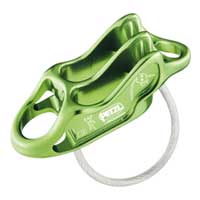
Petzl Reverso Belay Device
Like the ATC-Guide, the Reverso represents an upgrade on standard tubular devices owing to the inclusion of the two attachment points on either side of the main rope slots. Its “Reverso” mode allows the lead climber to belay one or two seconding climbers directly from an anchor point with more braking power than on standard tubular devices.
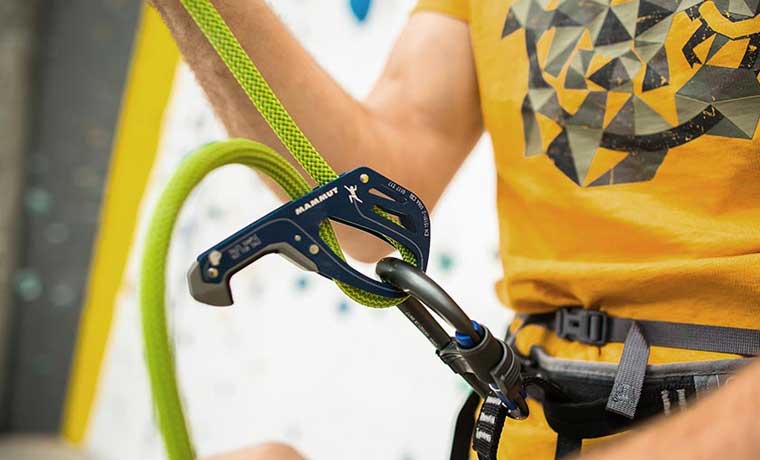
Assisted braking belay device (passive)
‘Passive’ belay devices earn their name on account of having no moving parts and work by pinching the rope against the karabiner. While the handling of these devices can feel a little fiddly to begin with, they’ve become popular amongst sport, trad, and multi-pitch climbers on account of their ability to provide the security of an active device without the added weight.
Main benefits of assisted braking belay devices (passive):
- Lighter than ‘active’ assisted-braking devices
- Easy to use
- Double-rope compatibility (in most cases)
- Versatility
How it works
As with standard tubular devices, the rope is fed through on a bight, but in the case of a fall snaps tight on the rope to auto-block a falling climber.
What scenarios it’s best suited to
- Climbing with a heavier partner
- Climbing with a beginner belayer
- When “working” a trickier route and the lead climber needs to sit on the rope or rest frequently
What sort of climbing is it best suited to
- All types: this belay device is a true all-rounder
Assisted braking belay device (passive) options
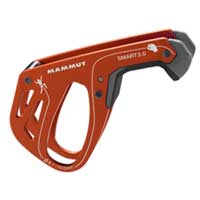
Mammut Smart 2.0 Belay Device
Smooth and easy handling, the peace of mind of assisted braking, and all at a weight of just 2.8 ounces, the Smart 2.0 merits is name. It offers any climber/belayer not using twin or half ropes solid, strain-free braking, smooth payout, and highly intuitive handling.
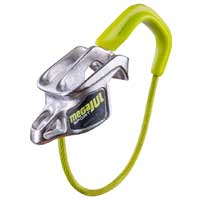
Elderid Mega Jul
Weighing in at a tiny 2.3 oz and able to perform any task you might ask of a belay device, the Mega Jul was a bit of a game-changer when first introduced a few years back. It is gaining popularity on account of its ability to combine the ease of use and light weight of a standard tuber with the added security of assisted braking.
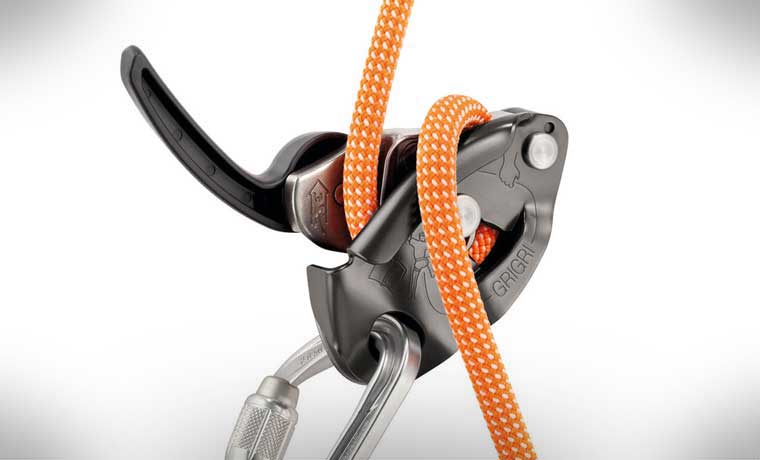
Assisted braking belay device (active)
If you have any doubts about the attention span of your belayer or simply prioritize safety over all else, an active assisted braking device is the way to go. When the climber goes into freefall, the auto-locking mechanism in these devices ensures that air-time is kept to a bare minimum, no matter what the belayer might be up to.
Main benefits of assisted braking belay device (active):
- Auto-locking mechanism means even if you partner is distracted or for some reason unable to catch and hold a fall, the fall will be halted automatically as soon as enough pressure is applied on the rope.
- Locking mechanism allows belayer to hold lead climber when resting without effort.
How it works
Uses moving parts to add stopping power or automatically lock when sudden force is applied to the rope, thereby giving the belayer more control.
What scenarios is it best suited to?
- Climbing with a heavier partner
- Climbing with a beginner belayer
- When “working” a trickier route and the lead climber needs to sit on the rope/rest frequently
- Climbing with partners prone to updating their Instagram feed at the most inappropriate times (i.e. when they’re supposed to be belaying you!)
What sort of climbing is it best suited to?
- Crag and sport climbing (can be used in multi-pitch climbing, but lighter devices are more practical)
Assisted braking belay device (active) options
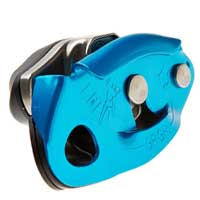
Petzl Grigri 2 Belay Device
This long-term favourite of crag-climbers and gym climbers the world over is so ubiquitous as to be almost synonymous with the term “assisted-braking device”. Feeding rope to your climber takes a little getting used to, but once you’ve got the knack the added security and the ease with which you can hold a “hanging” climber will make you a Grigri convert in no time.
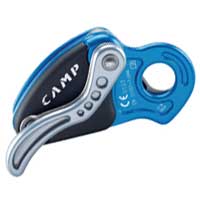
Camp USA Matik Belay Device
For many years Petzl’s Grigri lacked a serious rival in the assisted-braking belay device market, but in the Matik it finds stiff competition. This one doesn’t come cheap, but provides a smooth action and weighs in at a little less than the Grigri, making it just slightly more appealing for multi-pitch and trad climbers.
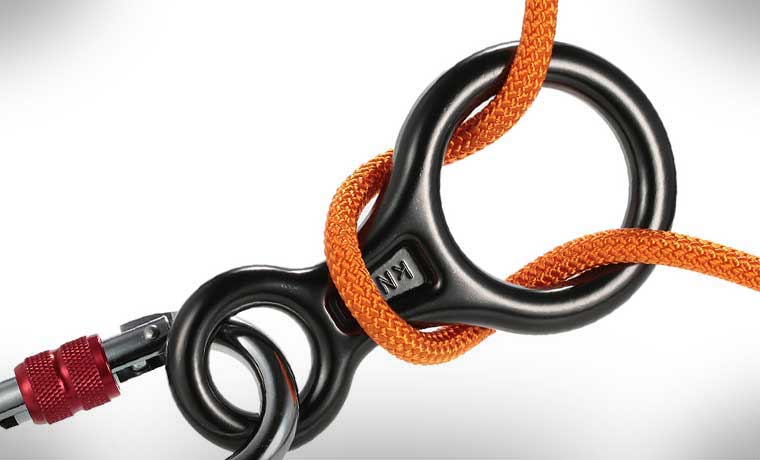
Figure 8 belay device
This old-school belay device has undergone something of a surprise renaissance in recent years with throwbackers, purists, and those less enamoured with the fuss and weight of assisted-braking devices.
Main benefits of figure 8 belay devices:
- Easy to thread even when wearing thick gloves
- Can be used with any thickness of rope
- Extra bulk dissipates heat better than tubular devices
- Old-school aesthetics (it looks cool!)
How it works
Pass a loop in the rope through the larger top hole, pull this over the small hole, then attach the device to your harness with a karabiner through the small hole with the dead rope locked off to the belayer’s side.
What scenarios it’s best suited to
- Rappelling
- Cold conditions
- When you feel the need to impress fellow climbers with old-school style and technical nous
What sort of climbing is it best suited to
- Multi-pitch trad routes
- Alpinism
Figure 8 belay devices options

Black Diamond Super 8 Belay Device
This modern take on the old-school classic is sure to win fans for its sleek aesthetics and fuss-free functionality. Would-be buyers, however, should beware that the braking power in this model is not improved on past designs and this device still has a tendency to twist ropes.



